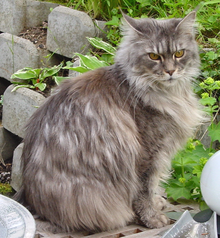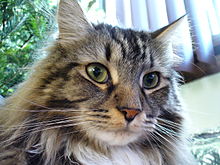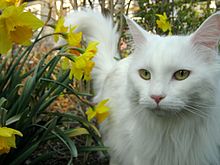This is an old revision of this page, as edited by Dana boomer (talk | contribs) at 14:30, 12 January 2009 (Reverting Duffymoon's edit, which changed sourced information). The present address (URL) is a permanent link to this revision, which may differ significantly from the current revision.
Revision as of 14:30, 12 January 2009 by Dana boomer (talk | contribs) (Reverting Duffymoon's edit, which changed sourced information)(diff) ← Previous revision | Latest revision (diff) | Newer revision → (diff) Breed of cat| Maine Coon | |
|---|---|
 | |
| Other names | Coon Cat Maine Cat Maine Shag |
| Origin | United States |
| Breed standards | |
| CFA | standard |
| FIFe | standard |
| TICA | standard |
| ACF | standard |
| ACFA/CAA | standard |
| GCCF | standard |
| Domestic cat (Felis catus) | |
The Maine Coon is a breed of domestic cat well known for its distinctive physical appearance. It is one of the oldest natural breeds in North America, specifically native to the state of Maine, where it is the official State Cat.
Although the Maine Coon's exact origins and date of introduction to the United States are unknown, many theories have been proposed. The breed was popular in cat shows in the late 1800s, but its existence became threatened when long-haired breeds from overseas were introduced in the early 20th century. The Maine Coon has since made a comeback and is now the second most popular cat breed.
The Maine Coon is generally noted for its large bone structure, its rectangular body shape, and a long, flowing coat. The breed can be seen in a variety of colors and are known for their intelligence and gentle personalities. Health problems, such as feline hypertrophic cardiomyopathy and hip dysplasia, are commonly seen in the breed, but testing is available to detect the genes responsible for causing these abnormalities.
History
Origin
It is unknown how and when the Maine Coon first came to the United States. There are only theories and folktales. One such folktale includes that of Marie Antoinette, the Queen of France, who was executed in 1793. Before her death, Antoinette attempted to escape France with the help of Captain Samuel Clough. She loaded Clough's ship with her most prized possessions, including six of her favorite long-haired cats. Although Antoinette did not make it to the United States, her pets safely reached the shores of Wiscasset, Maine, where they bred with other short-haired breeds and evolved into the modern breed of the Maine Coon.

Another folktale involves that of Captain Charles Coon, an English seafarer who kept long-haired cats aboard his ships. Whenever Coon's ship would anchor in the New England ports, the felines would exit the ship and mate with the local feral cat population. When long-haired kittens began appearing in the litters of the local cat population, they were referred to as one of "Coon's cats".
A theory which is biologically-based, though genetically impossible, is the idea that the modern Maine Coon descended from ancestors of semi-feral domestic cats and raccoons. This could have possibly explained the most common color of the breed (brown tabby) and the bushy tail, which is a characteristic trait. Another idea is that the Maine Coon originated between the matings of domestic cats and wild bobcats, which could explain the tufts of hairs that are so commonly seen on the tips of the ears. There have been reports of domestic cats breeding with bobcats.
Many breeders believe that the Maine Coon is descended from the pairings of local short-haired domestic cats and long-haired breeds brought overseas by English seafarers (possibly by Captain Charles Coon) or 11th-century Vikings. The connection to the Vikings is noted through the strong resemblance of the Maine Coon to that of the Norwegian Forest Cat, another breed which is said to be descendents of cats that traveled with the Vikings.
Cat shows and popularity

The first Maine Coon to be mentioned in literature was in 1861, when a black-and-white Maine Coon by the name of Captain Jenks of the Horse Marines was written about by co-owner F.R. Pierce. Pierce, who wrote a chapter about the breed in Frances Simpson's The Book of the Cat (1903), owned several other Maine Coons. During the late 1860s, farmers located in Maine would tell stories about their cats and hold the "Maine State Champion Coon Cat" contest at the local Skowhegan Fair.
On May 8, 1895, the first North American cat show was hosted at Madison Square Garden in New York City. A female Maine Coon brown tabby, named Cosey, was entered into the show. Owned by Mrs. Fred Brown, Cosey won the silver collar and medal and was named Best in Show. The silver collar won by Cosey was purchased by the Cat Fanciers' Association (CFA) Foundation with the help of a donation from the National Capital Cat Show. The collar is housed at the CFA Central Office in the Jean Baker Rose Memorial Library. Maine Coons subsequently became popular in cat shows in New York and a dozen Maine Coons were entered into a show in Boston in 1878.

In the early 1900s, the Maine Coon's popularity began to decline with the introduction of other long-haired breeds, such as the Persian, which originated in the Middle East. The last recorded win by a Maine Coon in a national cat show for over 40 years was recorded in 1911 at a show in Portland, Oregon. The breed was rarely seen after that. The decline was so severe that the breed was declared extinct in the 1950s, although this declaration was considered to be exaggerated and reported prematurely. The Central Maine Cat Club (CMCC) was created in the early 1950s by Alta Smith and Ruby Dyer in attempts to increase the popularity of the Maine Coon. For 11 years, the CMCC held cat shows and hosted exhibitions of photographs of the breed, and is noted for creating the first written breed standards for the Maine Coon.
The Maine Coon was denied provisional breed status by the CFA three times, which led to the formation of the Maine Coon Cat Club in 1973. The breed was finally accepted by the CFA under provisional status on May 1, 1975 and was approved for championship status on May 1, 1976. The next couple of decades saw a rise in popularity of the Maine Coon, with championship victories and an increase in national rankings. In 1985, the state of Maine announced that the breed would be named the official State Cat. The Maine Coon is the second most popular cat breed, according to the amount of kittens registered with the CFA.
Breed description
Maine Coons are one of the largest breeds of domestic cat. Males can weigh anywhere between 13 and 18 lb (5.9 and 8.2 kg) with females weighing between 8 and 12 lb (3.6 and 5.4 kg). The height of adults can vary between 10 and 16 in (25 and 41 cm) and they can reach a length of up to 40 in (100 cm), including the tail, which can reach lengths of up to 14 in (36 cm) and is long, tapering, and heavily furred. The body is solid and muscular, which is necessary for supporting their own weight, and the chest is broad. Maine Coons possess a rectangular body shape and are slow to physically mature; their full potential size is normally not reached until they are around three- or four-years-old.
In 2006, the Guinness World Records named a male purebred Maine Coon the "Longest Cat". Verismo Leonetti Reserve Red (better known as Leo) measures 48 in (120 cm) in length, from the tip of his nose to the tip of his tail, and weighs 35 lb (16 kg). He resides with his owner, Frieda Ireland, in Chicago, Illinois.
The Maine Coon is a longhaired, or medium-haired, cat. The coat is soft and silky, although texture may vary with coat color. The length is shorter on the head, and shoulders and longer on the stomach and flanks with some cats having a lion-like ruff around their neck. Minimal grooming is required for the breed, compared to other long-haired breeds, as their coat is mostly self-maintaining due to a light-density undercoat. The coat is subject to seasonal variation, with the fur being thicker in the winter and thinner during the summer.
Maine Coons can be seen in all colors with the exception of those indicating hybridization, such as chocolate, lavender, the Siamese pointed patterns or the "ticked" patterns. Such colors are unaccepted by breed standards. The most common color seen in the breed is brown tabby. All eye colors are accepted under breed standards, with the exception of the occurrence of blue-colored or odd-eyes (i.e., two eyes of different colors) in cats possessing coat colors other than white.
Maine Coons have several physical adaptations for survival in harsh winter climates. Their dense water-resistant fur is longer and shaggier on their underside and rear for extra protection when they are on top of wet surfaces or snow. Their long and bushy raccoon-like tail is resistant to sinking in snow, and can be curled around their face and shoulders for warmth and protection from wind and blowing snow. Large paws, and especially the extra-large paws of polydactyl Maine Coons, facilitate walking on snow and are often compared to snowshoes. Long tufts of fur growing between their toes help keep the toes warm and further aid walking on snow by giving the paws additional structure without significant extra weight. Heavily furred ears with extra long tufts of fur growing from inside help keep their ears warm.
Many of the original Maine Coon cats that inhabited the New England area possessed a trait known as polydactylism (having one or more extra toes on the feet). This trait is thought to have occurred in approximately 40% of the Maine Coon population in Maine at one time, but little evidence has been given to substantiate this claim. Polydactylism is rarely, if ever, seen in Maine Coons in the show ring since it is unacceptable by competition standards. The gene for polydactylism is a simple autosomal dominant gene, which has shown to pose no threat to the cat's health. The trait was almost eradicated from the breed due to the fact that it was an automatic disqualifier in show rings. Private organizations and breeders were created in order to keep polydactylism in Maine Coons from disappearing.
Maine Coons are known as the "gentle giants" and possess above-average intelligence, making them relatively easy to train. They are known for being loyal to their family and cautious—albeit not mean—around strangers, but are independent and not clingy. The Maine Coon is generally not known for being a "lap cat" but their gentle disposition makes the breed relaxed around dogs, other cats, and children. They are playful throughout their lives, with males tending to be aloof and females generally possessing more dignity. Many Maine Coons have a fascination with water and some theorize that this personality trait comes from their ancestors, who were aboard ships for much of their lives.
Health

Maine Coons are generally a healthy and hardy breed and have evolved to survive the New England climate. The most severe threat is feline hypertrophic cardiomyopathy (HCM), the most common heart disease seen in cats which is genetically inherited. HCM is a progressive disease and can result in heart failure, paralysis of the hind legs, and sudden death. A specific strain of HCM is predominantly seen in Maine Coons and can be fatal but testing services are offered. Of all the Maine Coons tested for the MyBPC mutation at the Veterinary Cardiac Genetics Lab at the College of Veterinary Medicine located at Washington State University, one-third tested positive.
Another common health problem is spinal muscular atrophy (SMA), another genetically inherited disease which causes the loss of the neurons in the spinal cord that activate the skeletal muscles of the trunk and limbs. Symptoms are normally seen within 3–4 months of age and result in muscle atrophy, muscle weakness, and a shortened life span. A test is offered to detect the genes responsible for SMA.
Hip dysplasia, an abnormality of the hip joint which can cause crippling lameness and arthritis, is commonly seen in Maine Coons. In a research survey finalized by the Orthopedic Foundation for Animals (OFA) in 2007, comprising at least 100 evaluations for each breed studied between January 1974 and December 2007, Maine Coons ranked number 26 at 23.1% for 959 evaluations. The Maine Coon is the only cat breed listed in the survey.
Polycystic kidney disease (PKD) is a slowly progressive disease that is prevalent among Maine Coons and was thought to plague only the Persian and Persian-related breeds. Symptoms typically occur around seven years of age and the effects are incurable. PKD generally leads to renal failure and is genetically inherited, so careful screening and testing are the only ways to prevent the disease from occurring.
References
- "Breed Information". Retrieved 2008-10-26. Maine Coon Breeders & Fanciers Association
- ^ Robins, Sandy. "Training Day". Popular Cats Series. 2. BowTie Magazines: 118–125. Retrieved on 2008-11-07. Maine Coons
- ^ "Maine Coon Synopsis". Retrieved 2008-10-26. American Cat Fanciers Association
- ^ Helgren, J. Anne. "Maine Coon". Retrieved 2008-10-26. Iams
- "History, Legends and Myths of the Maine Coon". Retrieved 2008-10-26. Maine Coon Rescue
- ^ "Breed Article: Maine Coon". Retrieved 2008-10-26. Cat Fanciers' Association
- Daly, Carol Himsel (2006). Maine Coon Cats. New York: Barron's Educational Series. p. 5. ISBN 0764134027.
{{cite book}}: Unknown parameter|coauthors=ignored (|author=suggested) (help) - ^ Simpson, Mike and Trish. "The Maine Coon: America's Native Longhair". Retrieved 2008-10-27. Maine Coon Breeders & Fanciers Association
- Link, Russell (2007). "Living with Wildlife: Bobcats". Retrieved 2008-10-27. Washington Department of Fish and Wildlife
- "Backgrounder: The Maine Coon Cat" (PDF) (Press release). 2008-09-28. Retrieved 2008-10-27. Maine Attraction Cat Fanciers
- Simpson, Frances (1903). Chapter 28: Maine Cats (PDF). Cassell & Company, Limited. pp. 325–331. Retrieved 2008-10-27. The Book of the Cat
- "The CFA Foundation". Retrieved 2007-10-27. Cat Fanciers Association
- "Kitten History: Maine Coon". Retrieved 2008-10-28. CatChannel.com
- "Title 1, § 217: State Cat". Retrieved 2008-12-07. The state cat shall be the Maine Coon Cat. Maine State Legislature
- Mattern, Joanne (2000). The Maine Coon Cat. Minnesota: Capstone Press. p. 4. ISBN 0736805656.
{{cite book}}: Unknown parameter|coauthors=ignored (|author=suggested) (help) - "Maine Coon: A Gentle Giant" (PDF). Retrieved 2008-10-31. Royal Canin
- "Maine Coon Cat" (PDF). Retrieved 2008-11-02. Cat Fanciers Federation
- "Verismo Leonetti Reserve Red". Retrieved 2008-11-02. Verismo Cat
- ^ "The ACFA Maine Coon Standard". Retrieved 2008-11-02. American Cat Fanciers Association
- "Choosing a Maine Coon". Retrieved 2008-11-02. PetPlace.com
- ^ "The Maine Coon: Cat Breed FAQ". Cat Fanciers. 2003. Retrieved 2008-11-02. Cite error: The named reference "Fanciers" was defined multiple times with different content (see the help page).
- Morgan, Diane. "Living Large". Popular Cats Series. 2. BowTie Magazines: 14–21. Retrieved 2008-11-07.
- ^ "The Origin of the Maine Coon". 1976. Retrieved 2008-12-15. PawPeds.com
- "The Origin of the Maine Coon - Part III". 1976. Retrieved 2009-01-08. PawPeds.com
- "Information & Articles relating to the Maine Coon Polydactyl Cat". Retrieved 2008-11-02. Maine Coon Polydactyl International
- King, Lucinda. "So What Happened to the Maine Coon Polydactyl?". Retrieved 2008-11-02. Maine Coon Polydactyl International
- Grindell, Susan. "Summary". Retrieved 2008-11-02. Maine Coon Polydactyl International
- Grindell, Susan. "The effects of Polydactyly". Retrieved 2008-11-02. Maine Coon Polydactyl International
- Grindell, Susan. "Incidence in the Original Breed Population and Today". Retrieved 2008-11-02. Maine Coon Polydactyl International
- ^ Morgan, Diane. "Living Large". Popular Cats Series. 2. BowTie Magazines: 14–21. Retrieved 2008-11-07.
- Gompf, Rebecca. "Feline Hypertrophic Cardiomyopathy". Retrieved 2008-11-24.
{{cite web}}: Unknown parameter|coauthors=ignored (|author=suggested) (help) Cat Fanciers' Association - "Hypertrophic Cardiomyopathy Genetic Mutation Testing Service for Cats". Retrieved 2008-11-20. Washington State University
- "Frequently Asked Questions about the test for the Hypertrophic Cardiomyopathy Mutation". Retrieved 2008-11-21. Washington State University
- ^ "MCBFA Health Information & References". Retrieved 2008-11-20. Maine Coon Breeders & Fanciers Association
- "Hip Dysplasia Statistics". Retrieved 2008-11-21. Orthopedic Foundation for Animals
Further reading
- Bass, Sharyn P. (1983). This Is the Maine Coon Cat. Neptune City, New Jersey: T.F.H. Publications. ISBN 0-87666-867-8.
- Hayman, Tracey K. (2001). Maine Coon Cat. Dorking, England: Interpret Publishing. ISBN 1-84286-011-9
- Hornidge, Marilis (2002). That Yankee Cat: The Maine Coon. Gardiner, Maine: Tilbury House. ISBN 0-88448-243-X.
External links
- Cat Fanciers' Association Maine Coon Cat Breed Council
- Maine Coon Breeders and Fanciers Association
- United Maine Coon Cat Association
- Verismo Leonetti Reserve Red, 2006 Guinness World Record holder for "Longest Cat".